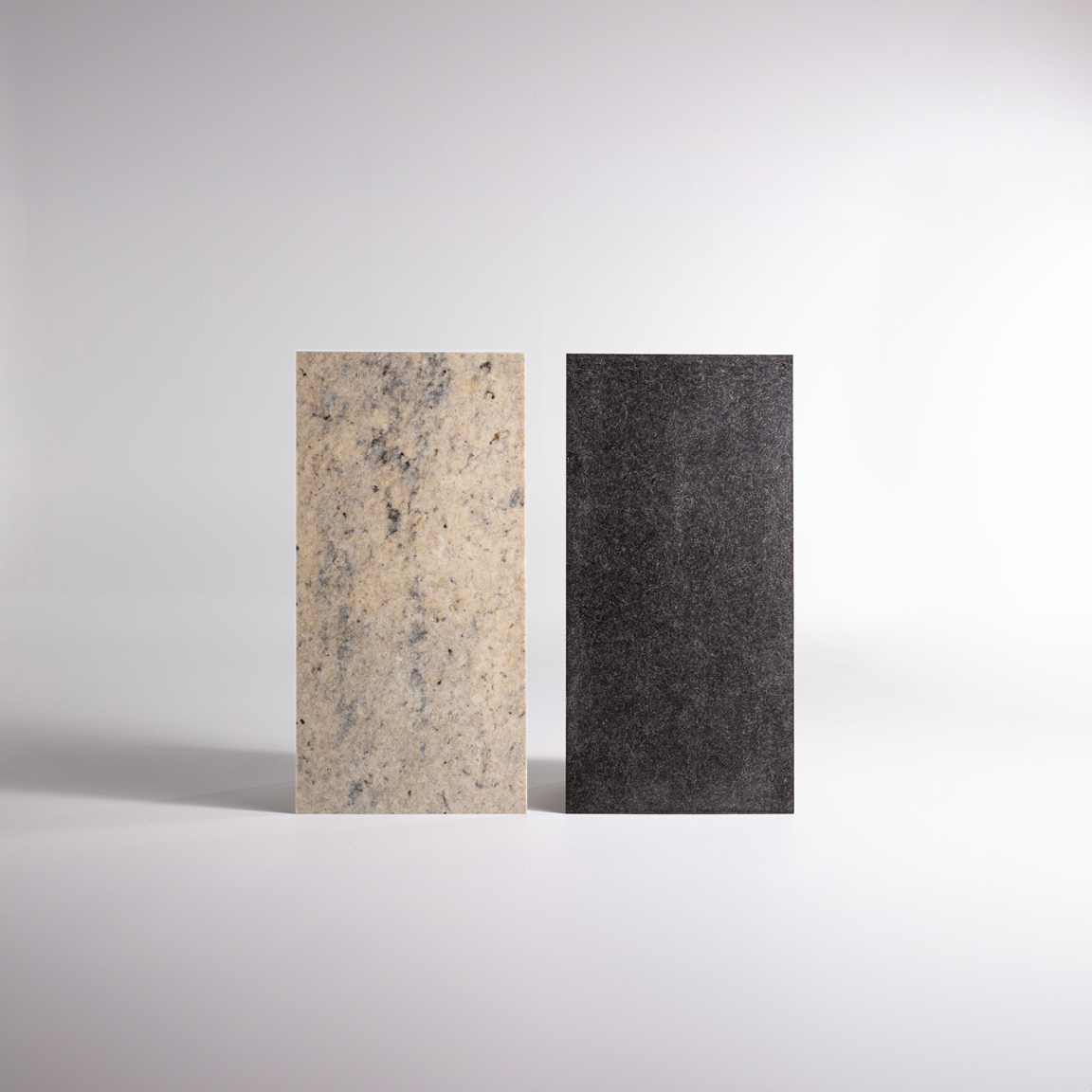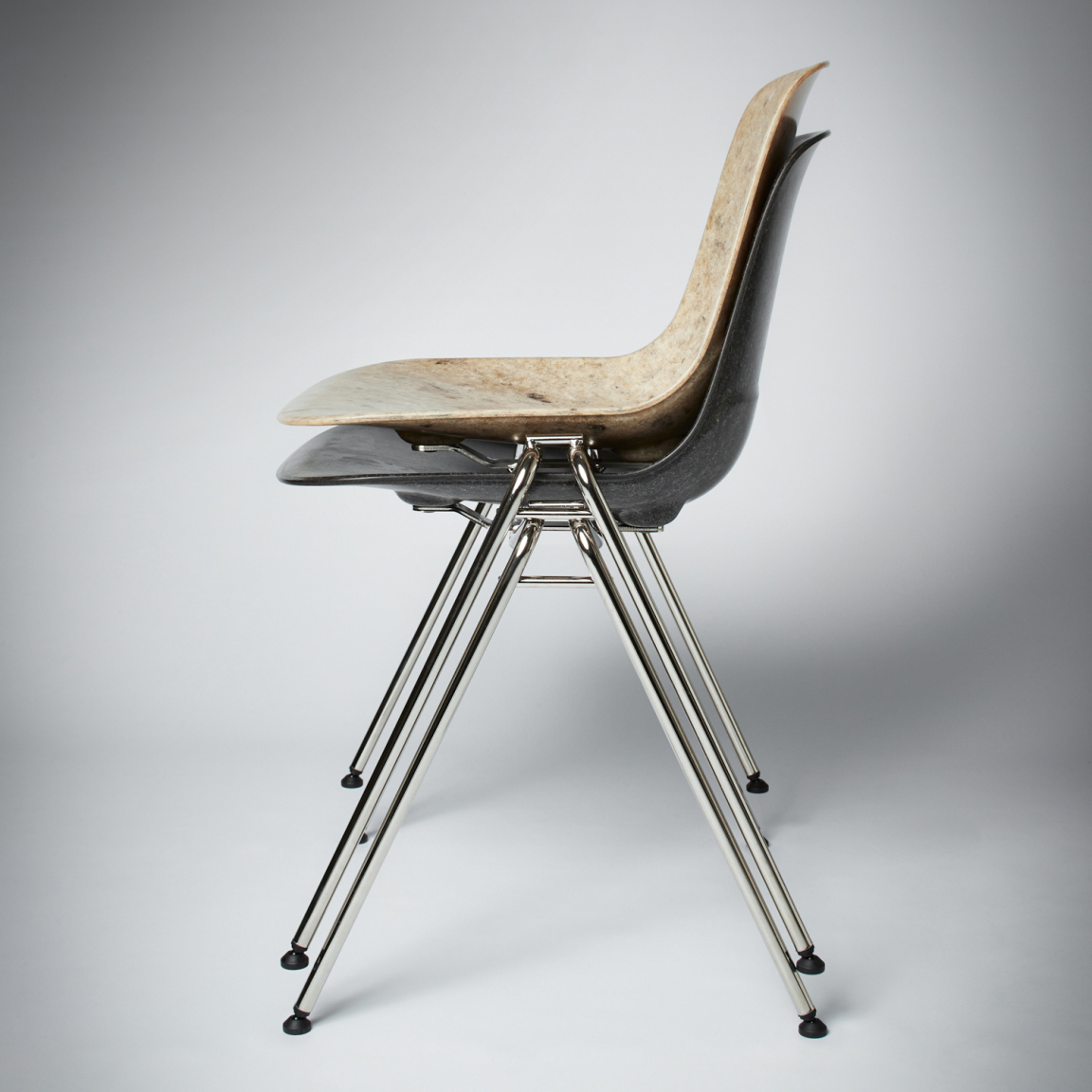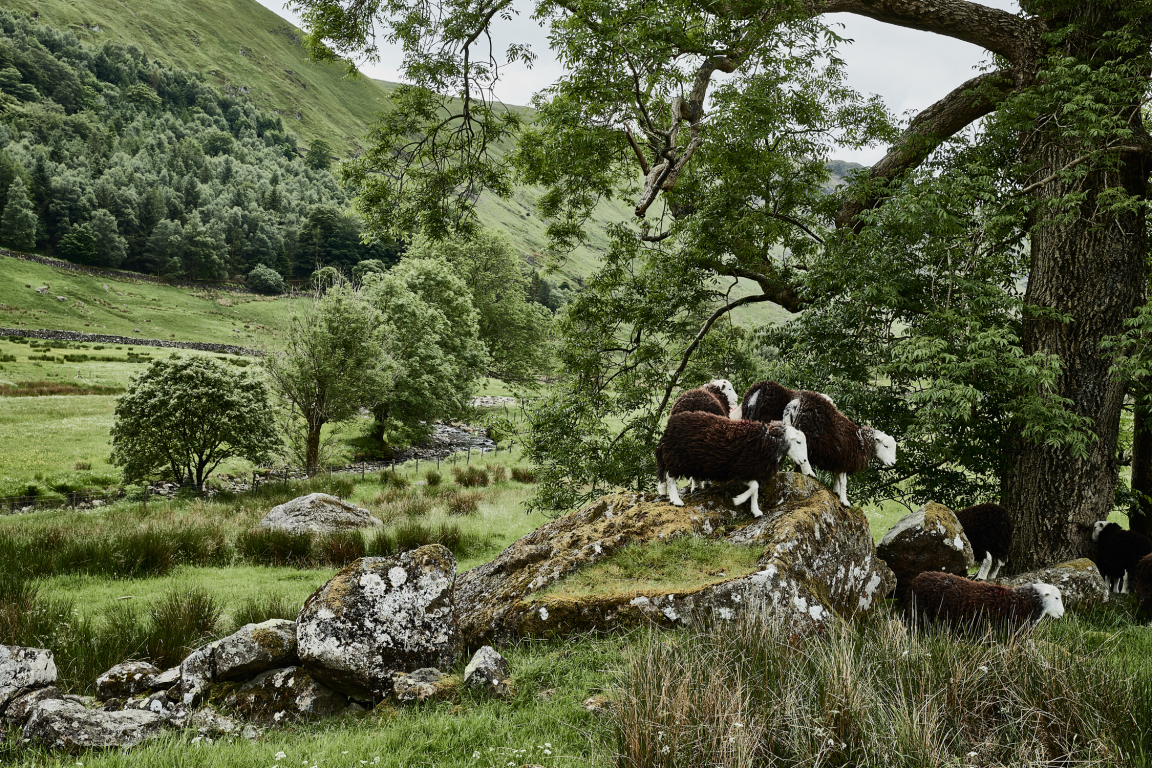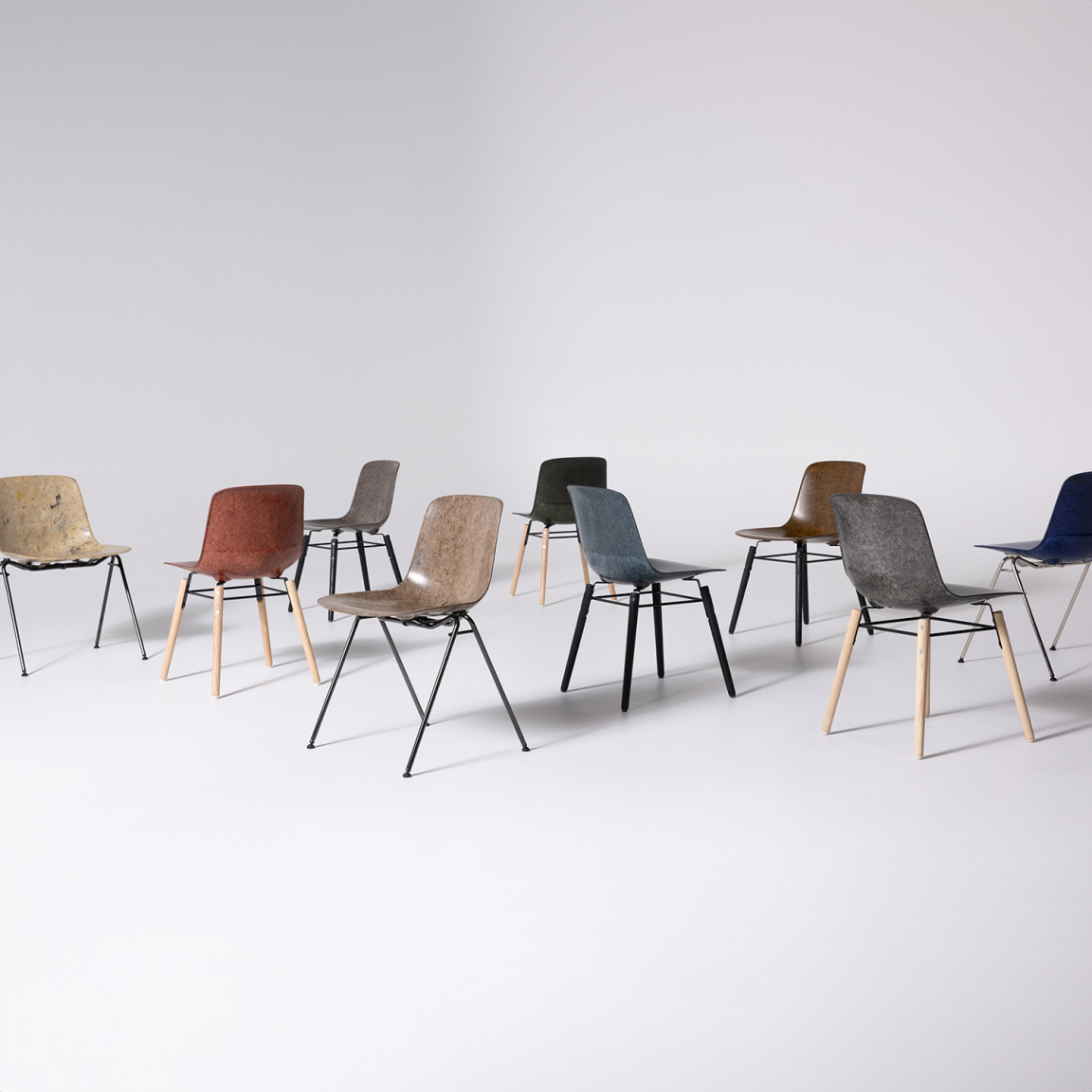Solidwool transforms British by-product into built-to-last furniture.

Aligning with our own Beautiful and Useful mantra, Solidwool prides itself on creating both beautifully crafted and meaningful objects that people connect with, use, and cherish - using British wool.
Harnessing the incredible yet undervalued properties of this natural, regularly discarded material, Solidwool sources each fleece from either the Lake District or North Wales.
Solidwool’s focus on material provenance within its products does not stop there. UK sourced Ash legs are made by a wood-turner local to them in Devon to make their Herdwick and Welsh Mountain wool-based Hembury chairs and side tables. In addition to this, the wool is bonded with a resin made using byproducts from the paper industry and bio-fuel production.
Despite the wool fibres being solidified in a part bio resin, the material has a unique tactile quality, as if the fleece is fighting to unfurl from the sheet in which it is encased. Something the team at Solidwool is keen showcase to designers coming into Material Source Studio in Manchester and Glasgow, where it is a partner.
Keen to learn more about what was first developed as a sheet material, and later transformed into a product portfolio suitable for commercial and residential interiors, we sat down with the team behind Solidwool to discover how the venture began, explore the design thinking behind its recently released colour palette – taking cues from the rugged landscapes from which the wool originates - and uncover what's next.

To start, please can you introduce us to Solidwool?
“Solidwool is a unique composite material, made in the UK using British wool and bio-resin. Think fibreglass, but with wool.
“Back in 2013, we decided to take something unwanted and abundant - hardy British wool fleece - and turn it into something beautiful, believing good design shouldn’t compromise our environment - principles that we still work to today.
“We use Solidwool to make flat sheet material, and furniture. Our Hembury Chairs and Side Tables are made using our Solidwool composite, celebrating the beauty and versatility of British wool.”
With the demand for British wool reported as having been 'in steady decline since the 1950s', how does Solidwool support British farmers and promote value in wool as a versatile material?
“The company was born with the idea of wanting to help British wool find its value again. We buy British wool, specifically Herdwick and Welsh Mountain, which are both hardy native breeds.
“We’ve always hoped that by making something beautiful and functional that has real purpose, we can increase the demand and value of wool. Wool has so many incredible natural properties that are under-utilised. We are trying to play our part in communicating that to a wider audience.”

You use different varieties of wool, specifically sourced from the Lake District and Wales. How do these varieties differ from each other?
“In simple terms, relating to how we use it – colour. We started with the Herdwick fleece, a breed native to the Lake District, which has a very distinctive dark grey colour with lighter coarse guard hairs.
“We were looking to expand our offering and so went in search of a fleece of contrasting colour. Welsh Mountain wool has a similar coarse texture as Herdwick, but offers two very different colours. We marble wool from both black and white Welsh Mountain sheep to create unique layers of texture and tone.”


How do you go about selecting the wool you use across the UK?
“We work closely with the wool industry to source these specific breeds as we want to utilise wool that has been deemed undesirable, or difficult to use. British Wool put us onto the Herdwick Breed when we were first developing the material. We were told it was the most undervalued, due to its robust and wiry nature and its resistance to dye.
“The cost of shearing a sheep can be more than the price a farmer can get for the fleece – especially when it comes to hardy British breeds – we chose these breeds for that exact reason, to highlight their importance and their value.”
Talk us through the benefits of working with this natural material
“We can’t ignore its abundance as a by-product of sheep farming.
Fleece is readily available and, in many cases, going to waste.
“For us, the properties of wool that we find valuable are its beautiful visual texture, captured and celebrated in Solidwool, as well as its natural elasticity, and its strength. The strength, elasticity and texture of the wool is integral to the design of the Hembury chair.
“The wool fibres give the composite a flexible reinforcement – an unmatchable property for an ergonomic chair for example.”



What’s the process for creating a Hembury chair or side stool?
“What people may not know is that the very first Solidwool mould was completely experimental - a labour of love built in a shed!
“With years of development and experimentation under our belts, we have invented our own proprietary system. It is a process which we continue to refine. It remains very labour intensive, and each sheet, side-table and chair is made and finished individually.
“UK sourced Ash legs are made by a wood-turner local to us in Devon, and our frames are made in Peterborough using recycled steel. The entire moulding and construction process takes place in our Devon workshop.”
Tell us more about the bio resin you use. What is it made from?
“The bio-resins we use have 50% bio-based renewable content, sourced from waste streams of other industrial processes, such as wood pulp from the paper industry and bio-fuel production.
“The bio-resin manufacturer claims a 33% reduction in Carbon Footprint and Greenhouse Gas Emissions during manufacture compared to traditional petrochemical based resins. Plus, the green chemistry of bio-resins eliminates many harmful toxins, making it a more pleasant resin for us to work with.
“The use of bio-resin allows us to create a strong and durable composite with a lower environmental impact. We’ve worked over the past few years to add more wool content and reduce the bio-resin content. We are currently working with 50% wool and 50% bio-resin, which is nearly twice as much as was in our early designs.
“That doesn’t mean we’re going to sit back and relax; we’re constantly looking to evolve and improve how we can be even better. We hope that bio-resin technology will improve with increased demand, and we will follow those advances keenly.”


Who predominantly are your clients? Which sectors do you support?
“We have quite a broad spectrum of clients, ranging from larger commercial projects, architects, and interior designers, on top of residential. We enjoy selling chairs and side tables directly to the end client, for people’s homes.
Our clients all have one thing in common, they care about how and where things are made, and what impact they have on our environment.
Can Solidwool pieces be recycled?
“Solidwool is not currently recyclable – it is of course something we are conscious of. Our aim under our current limitations is to create a piece of furniture that is long lasting and functional.
“Our focus is to make something beautiful and meaningful that people can connect with, cherish and use; even hold on to and pass down through generations. We hope by using timeless design principles each Solidwool piece has longevity.
“Again, we always have one eye on advances in this area and we’re committed to making Solidwool the best composite it can be through experimentation and innovation.”


As well as furniture, you also offer Solidwool as a sheet material. Can you tell us more about this? What fuelled its launch? And where can it be used?
“Solidwool was first developed as sheet material – we then chose to design and create a chair and side table to highlight its potential.
“Sheet material is incredibly versatile, like most of its other sheet material counterparts, it can be milled, drilled and cut using mechanical, laser and water jet. Sheets can be laminated onto other materials or bonded together to make a thicker composite. Solidwool can be sanded, finished and polished to a gentle sheen or for a high gloss finish. A secondary clear coat can also be applied.
“We’ve seen Solidwool used in some incredibly exciting projects over the years, from tabletops and work surfaces to sunglasses and knife handles.”
You've recently become a partner at Material Source Studio in Manchester and Glasgow. How's it been so far?
“The team at Material Source are great to work with, they provide a lot of feedback and are responsive to all enquiries, big or small.
“It’s important for clients to experience the visual tactility of Solidwool in person. Partnering with Material Source in Manchester and Glasgow allows us the opportunity to connect with clients in the north of the UK. Material Source clients seem curious about material provenance, so it feels like a great fit.”


You've just launched a series of brand-new colours. Where did the inspiration stem from for this new palette?
“It’s important to us that Solidwool appeals to a wide range of clients and is usable in a variety of projects. We therefore set a goal to developing colours that could sit comfortably in a number of settings quite early on.
“We looked to our environment when developing the colours, choosing shades of ochre, lichen and forest green, as well as some stronger tones like tan and cobalt. We made sure the texture of the fleece is still very much visible as this is so significant to us.
“It was also important that the colours all complemented each other – giving clients the choice of playing with combinations of colour, as well using multiples of the same shade.”
What's next for Solidwool?
“We want to spread the word – we’re still a relatively niche product. Our goal is to make Solidwool the most natural, lowest impact and highest quality wool composite material out there and to be considered as a sustainable alternative to today's petrochemical based composites.
“We want innovators to use Solidwool as a creative material. It holds so much potential, and we are excited by all the ways in which it can be used – we look forward to seeing the path Solidwool carves for itself.”
Discover more about Solidwool by visiting Material Source Studio - Manchester and Glasgow.
All photography credits belong to Solidwool




